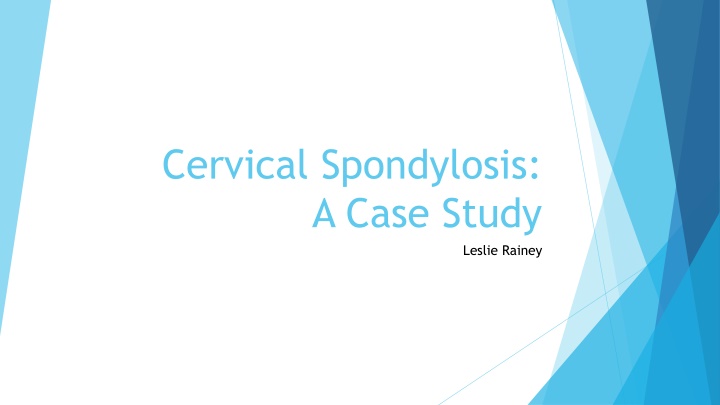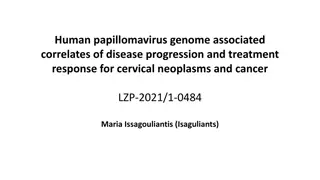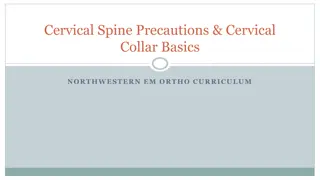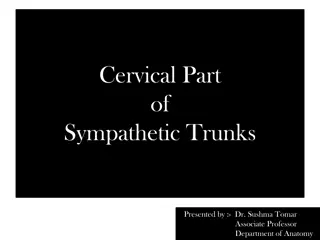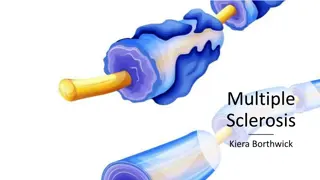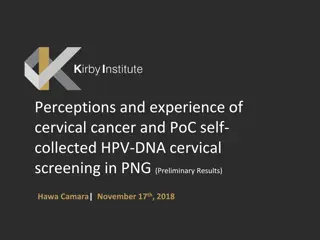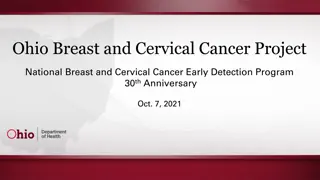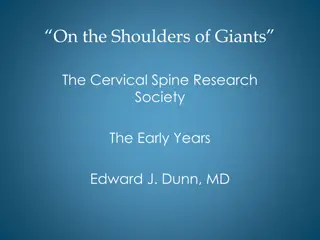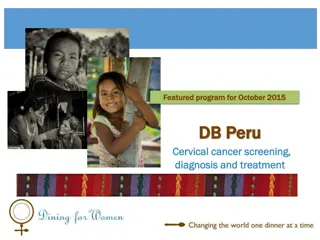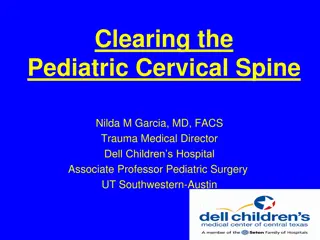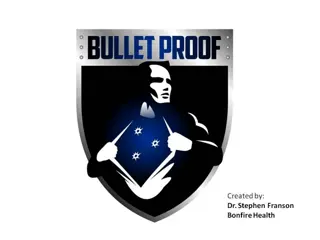Cervical Spondylosis: Understanding Symptoms, Evaluation, and Treatment Options
Cervical spondylosis is a degenerative condition of the spine that can lead to neck pain, limited range of motion, and other discomforts. In this case study of an 85-year-old female, the subjective and objective evaluations reveal symptoms and physical findings associated with cervical spondylosis. Treatment goals aim to improve cervical rotation, reduce neck pain, and enhance functional abilities over an eight-week period.
Download Presentation

Please find below an Image/Link to download the presentation.
The content on the website is provided AS IS for your information and personal use only. It may not be sold, licensed, or shared on other websites without obtaining consent from the author.If you encounter any issues during the download, it is possible that the publisher has removed the file from their server.
You are allowed to download the files provided on this website for personal or commercial use, subject to the condition that they are used lawfully. All files are the property of their respective owners.
The content on the website is provided AS IS for your information and personal use only. It may not be sold, licensed, or shared on other websites without obtaining consent from the author.
E N D
Presentation Transcript
Cervical Spondylosis: A Case Study Leslie Rainey
What is Cervical Spondylosis1,2? Spondylosis, meaning vertebra in Greek, is a general term for nonspecific, degenerative changes of the spine Degenerative changes occur due to aging in vertebral discs, facet and uncovertebral joints, and vertebral bodies bone formation or osteophytes due to increased stress Can result in cervical canal stenosis, narrowing of foramen, compression of nerve roots, and radicular symptoms Pathophysiology theory: desiccation of vertebral disc (90% water in early adulthood to 69% water by eighth decade of life) Height of disc decreases and annulus fibrosis is weakened
Examination and Evaluation of Mrs. W Subjective 85 year old female Dull ache, occasional sharp pain Dx of cervical spondylosis from outside provider Aggs: turning head, reading Eases: rest Imaging showed extensive degenerative changes of C spine PMHx: HTN (controlled w/ meds) Lives with husband Chief complaint neck pain, loss of ROM, and frequent headaches, mild numbness and tingling Completely independent with all ADLs Has extended family support in the area Insidious onset, 2 years Pain 7/10 at worst, 2/10 at best
Examination and Evaluation of Mrs. W Objective Increased thoracic kyphosis, forward head and neck, rounded shoulders 4 11 Strength of UE: WFL ROM: Shoulder WFL Cervical Rotation: 39 / 43 Cervical Lateral Flexion: 18 / 20 Cervical Flexion: 30 Cervical Extension: 15 (-) Spurling (+) crepitus (+) Distraction Intact sensation Reflexes normal NDI: 33/50 (66%)
Goals Increase cervical rotation to 60 and lateral flexion to 45 bilaterally in 8 weeks to demonstrate improved function in ADLs Decrease NDI score from 33/50 to 23/50 to demonstrate improvement in symptoms of neck pain 8 weeks Decrease pain with neck positioning from 7/10 to 2/10 so patient can read for 30 minutes without a headache in 8 weeks
Intracranial Aneurysm4,5 Aneurysm: weak or bulging spot on the wall of an artery due to wear and tear Intracranial saccular aneurysms occur in 1-2% of population 80-85% of non-traumatic subarachnoid hemorrhages Primarily in proximal arterial bifurcations in the circle of Willis (85% are anterior) 20% of patients have more than one aneurysm More common in women (3:1) Can be associated with some inherited disorders Image5
Intracranial Aneurysm: Diagnosis4-6 Asymptomatic vs. Symptomatic (CN deficits) Identified on CT or MRI CTA or MRA Risk Factors: Smoking HTN Congenital abnormality Family history Age >40 Gender Drug use Image5
Intracranial Aneurysm: Prognosis4,6-8 SAH due to ruptured aneurysm has poor prognosis Treatment vs serial imaging Endovascular coiling vs. open surgical clipping Considerations: risk of hemorrhage, size and location, age and health of patient, family history, surgical risks, patient preference Predictors of rupture: smoking, size of aneurysm (>10mm), age Health-promoting behaviors & perceived stress
Intervention: Conservative Management Plan of Care HEP Chin Retractions & Scap Squeezes (10x10) Manual Therapy Upper Trap/LS/Pecs stretch (3x30 seconds) Postural Education Shoulder Ext, IR/ER w/ Theraband (3x30) Therapeutic Exercise Images9-11
Evidence-Based Practice12,13 Strong evidence: Multimodal approaches (stretching/strengthening, mobilizations/manipulation) reduced pain, improved function, and resulted in favorable Global Perceived Effect in the long term Moderate evidence: Direct neck strengthening and stretching exercises for chronic mechanical neck disorders Reduce Headache: Cervical spine manipulation and mobilization Strengthening of neck and upper quarter muscles Postural education
Outcome Measures14 Neck Disability Index (NDI) Patient Specific Functional Scale Disabilities of the Arm, Shoulder, Hand (DASH) Headache Disability Index Depression Anxiety Stress Scale (DASS)
Outcome Mrs. W only came for three visits Reported lessening of sx after first couple treatments Having another MRA in a couple months to monitor aneurysm Did not have a chance to reassess ROM or progress with any of her goals
Bibliography 1. 1989;(239):69-93. Lestini WF, Wiesel SW. The pathogenesis of cervical spondylosis. Clin Orthop Relat Res 2. Date 2018. Available at: https://www-uptodate-com.libproxy.lib.unc.edu/contents/clinical- features-and-diagnosis-of-cervical- radiculopathy?search=cervical%20spondylosis§ionRank=1&usage_type=default&anchor=H7& source=machineLearning&selectedTitle=1~33&display_rank=1#H7. Accessed November 27, 2018. Robinson J, Kothari MJ. Clinical features and diagnosis of cervical radiculopathy. Up To 3. https://www.healthclues.net/cervical-spondylosis. Accessed November 27, 2018. Cervical Spondylosis | Neck Pain | Tests and Treatment. Available at: 4. https://www.bafound.org/about-brain-aneurysms/brain-aneurysm-basics/. Accessed November 25, 2018. Brain Aneurysm Basics Brain Aneurysm Foundation. Available at: 5. history, management options, and familial screening. Lancet Neurol 2014;13(4):393-404. doi:10.1016/S1474-4422(14)70015-8. Brown RD, Broderick JP. Unruptured intracranial aneurysms: epidemiology, natural 6. probability of and risk factors for aneurysm rupture. J Neurosurg 2000;93(3):379-387. doi:10.3171/jns.2000.93.3.0379. Juvela S, Porras M, Poussa K. Natural history of unruptured intracranial aneurysms:
Bibliography 7. intracranial aneurysms. Neurointervention 2014;9(2):63-71. doi:10.5469/neuroint.2014.9.2.63. Jeong HW, Seo JH, Kim ST, Jung CK, Suh S-I. Clinical practice guideline for the management of 8. behaviours and perceived stress in aneurysmal rupture. J Clin Nurs 2018;27(5-6):e1068-e1077. doi:10.1111/jocn.14149. Lee M-S, Park CG, Hughes TL, Jun S-E, Whang K, Kim N. The predictive role of health-promoting 9. for Total Back Care. Available at: http://totalback.com/top-neck-shoulder-stretches-trapezius- stretch/. Accessed November 27, 2018. The Center for Total Back Care Top Neck and Shoulder Stretches: Trapezius Stretch - The Center 10. stretch.html. Accessed November 27, 2018. Levator scapulae stretch. Available at: http://www.physiowarzish.in/levator-scapulae- 11. https://www.saintlukeskc.org/health-library/doorway-pectoral-stretch-flexibility. Accessed November 27, 2018. Doorway Pectoral Stretch (Flexibility) | Saint Luke s Health System. Available at: 12. disorders: a systematic review. J Rheumatol 2007;34(5):1083-1102. Gross AR, Goldsmith C, Hoving JL, et al. Conservative management of mechanical neck 13. neck pain. J Orthop Sports Phys Ther 2004;34(11):686-96; discussion 697. doi:10.2519/jospt.2004.34.11.686. Childs JD, Fritz JM, Piva SR, Whitman JM. Proposal of a classification system for patients with 14. international multidisciplinary survey. Open Orthop J 2013;7:506-520. doi:10.2174/1874325001307010506. Macdermid JC, Walton DM, C t P, et al. Use of outcome measures in managing neck pain: an
